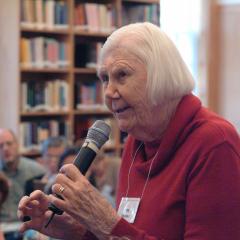Paul Knitter on the Promise of Interreligious Dialogue
Paul Knitter is the Emeritus Paul Tillich Professor of Theology, World Religions, and Culture at Union Theological Seminary in New York City. The Seminary’s vision for the Tillich Chair—to “promote a dialogue of religious communities that will both enrich the religions and promote the well-being of the people and planet”—has guided every phase of his long and distinguished career. Knitter also was co-general editor of the Orbis Books Faith Meets Faith series on interreligious dialogue, which includes the Center titles Subverting Hatred: the Challenge of Nonviolence in Religious Traditions and Subverting Greed: Religious Perspectives on the Global Economy. He co-edited the latter with Chandra Muzaffar. Mitch Bogen spoke with Professor Knitter in early 2008 about his hopes for these books as educational tools in the quest for global peace and justice.
MB: How do the books Subverting Hatred and Subverting Greed exemplify the goals and ideals of the Orbis Books Faith Meets Faith series, of which you have served as co-general editor?
PK: Both of these books not only exemplify, but also carry forward, the goals and ideals of the series. The series, established more than 25 years ago, was intended to affirm and expand what was the animating energy in Orbis Books’s editorial philosophy from its own beginnings: a commitment to what Christians call liberation theology. This meant a commitment to this theology’s driving concern to show, and to live, the vital link between “being religious” and “acting for peace with justice.”
The Faith Meets Faith series developed out of the realization that in today’s world, one must be religious interreligiously and one must act for justice and peace interreligiously. The challenge of bringing about a world of greater justice, compassion, and flourishing is simply too big for any one religion. Men and women from all religions must work together and enrich one another’s efforts in transforming a world of hatred and greed into one of compassion and sharing.
And here, precisely here, is the contribution of our two collections that seek to “subvert hatred and greed” by assembling the unique contributions of multiple religions. But the advantage these two books have over many of the other titles in the Faith Meets Faith series—and the reason, perhaps, why they have sold so well — is that they bring the voices of differing religions together in an extraordinarily accessible and practical way. They stand as two of the towering pillars in our series. And I’m so proud to have them in the series.
All religions, in often very different ways, want to “subvert” hatred with love and greed with compassion
Paul Knitter
In his Foreword to Subverting Hatred, Daisaku Ikeda speaks of interreligious dialogue as pointing toward “creative symbiosis,” and you spoke, in your Introduction to Subverting Greed, of the “polyphonic” harmonizing created by the essays in that book. Can you reflect on these ideas of symbiosis and polyphony in the context of our global challenges?
Both of these images—the working together of symbiosis and the blending of polyphonic voices—describe accurately the kind of dialogue that the world today stands in need of. It’s a coming together of religions in which each offers its unique contribution to the solving of a common problem. So there is unity in the problem that confronts all the religions — namely, the suffering caused to humans and to the planet because of violence and greed. But there is diversity in the responses from the various religions. And yet, because the diverse contributions are aimed at one goal — the promotion of peace and social justice—we find that the religious differences integrate symbiotically and complement one another polyphonically in their commitment to a common goal.
Why are these books important? Has their importance changed in the years since their creation?
The academic importance of these books for me, and I know for many, lies in the way they offer a practical response to a tangled and controversial scholarly question: Can we find a common ground for interreligious dialogue? Many scholars of philosophy, anthropology, and religion believe that we cannot. They argue that each religion has grown up and sees the rest of the world from a particular cultural context. There is no one cultural context for all the religions; therefore, no common ground.
Well, these two books, Subverting Hatred and Subverting Greed, make clear, I believe, that if the religions do not share any common cultural ground, they still can identify common ethical problems. All of them, in often very different ways, want to “subvert” hatred with love and greed with compassion. And they can work together in trying to achieve this shared goal.
Besides this academic importance, these two books also share a practical importance that is more relevant and urgent than ever. It seems that in our world today, especially since the events of 9/11 and the events after 9/11, there is an ever more frightening amount of hatred and violence, as well as more greed and exploitation, among nations and within nations. Even more frightening, and perplexing, is the way religion is often used to justify violence and animosity or to sanctify greed and consumerism. For this reason, the goals of these two books are more urgent than ever.
Religious people must work together to diminish violence and exploitation and to counteract the abuses of their religions. They must show the world that religions offer much greater resources for peace than for war and that they hold up the ideal of service rather than selfishness. Precisely such understandings of the role of religion in our contemporary world are offered by these two books.
What are the unique attributes of these books as resources for teaching and learning?
Having used both books in courses I have taught, I can vouch for their unique pedagogical qualities: They have helped me make religion interesting and engaging for students—even for undergraduates who have been “turned off” by religion! These books can help standard courses on comparative religions to come alive. Instead of studying from the academic question of “What do these religions teach or practice?,” we study the religions from the pragmatic question of “How can these religions help us solve the problems of war and violence or poverty and injustice?” With this approach, students come to the study of religions with their own questions. And as Paolo Freire has reminded us, students learn only when they feel their own questions.
What else should people know about these books?
That the authors of the essays that make up these books are scholars who, we can say, are trying to practice what they preach. They are scholars who are also practitioners, and some of them are activists. They believe, and are trying to show in their own lives, that religious faith can not only transform one’s heart, it can also transform the world; it not only can bring peace to one’s spirit, but it can bring peace to the world. It is possible to subvert hatred and greed, in our hearts and in our world. The authors of these books believe this, and they try to communicate it in what they have written.



